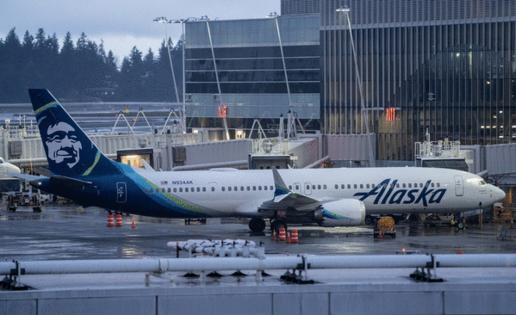Why Alaska Air wants Portland to be its Sea-Tac 'relief valve'
Published in Business News
As Alaska Airlines embarks on its mission to become a trans-Pacific carrier, connecting the West Coast to Asia, its Seattle hub will be the center of connections.
Neighboring Portland, then, will be the "relief valve," CEO Ben Minicucci told financial analysts on an earnings call Thursday.
As Alaska expands its international destinations, it will shuffle some connecting flights that would have routed through Seattle to stop in Portland instead. That frees up room in the Seattle airspace for local travelers and flights that would be better served by passing through the Puget Sound region, like connections to Tokyo, Japan, Ketchikan, Alaska and Bellingham.
In Seattle, connecting traffic was up 15% in the first quarter this year compared to the year before.
In Portland, connecting bookings are up 200% in May and June, the first two full months of Alaska's new connections structure.
"Portland is a huge opportunity for us," Minicucci said on the analyst call Thursday. "You'll see us invest more in Portland and creating that connecting complex as an opportunity to offload Seattle a little bit."
Minicucci was pointing to travel in Seattle and Portland at the start of the year to illustrate how Alaska's long-term intercontinental strategy was already working, even as the industry overall has seen demand slow amid President Donald Trump's trade and immigration policies.
Alaska lost $166 million in the first three months of the year, according to financial results released Wednesday. The airline usually sees a dip in the first quarter, said Ryan St. John, Alaska's vice president of finance, in an interview before the earnings release, but broad economic uncertainty led to a greater loss than expected.
But Alaska and its industry peers are optimistic that even if the current trajectory continues and growth slows for the year, they can still weather the turbulent days ahead.
Alaska, particularly, did not deviate from its long-term strategy that envisions new trans-Pacific flights and an ambitious return for investors.
"I'll say this with complete confidence: Our company is significantly undervalued relative to where we're headed and the strength we're showing in areas within our control," Minicucci said.
The airline's intercontinental growth hinges on its recent merger with Hawaiian Airlines, finalized in September, which will allow it to tap into a new widebody fleet of aircraft to more easily fly across the Pacific. Seattle will be Alaska's "new global gateway," with plans to add 12 new intercontinental routes from Seattle by 2030, including flights to Tokyo-Narita, Japan, in May and Seoul, South Korea, in September.
At the same time, Alaska has canceled a few routes as it reallocates capacity from some underperforming markets to another, including routes connecting San Francisco and Chicago; Los Angeles and Washington, D.C. and Austin and Honolulu. In Seattle, it canceled a flight to Dallas and Nassau, in the Bahamas.
On the investor call Thursday, one analyst put the shifting flights in California terms, asking Alaska executives if new San Diego flights came at the expense of San Francisco routes.
Alaska's Minicucci and Chief Commercial Officer Andrew Harrison said they didn't see it that way.
"We're doing it smart, we're doing it incremental and I think overall Air Group and our guests are going to benefit from this," Harrison said.
Responding to economic uncertainty
Meanwhile, Alaska did not release full-year guidance with its quarterly earnings this week, following many of its industry peers in signaling that the economic uncertainty may disrupt projections.
United stuck to its predictions laid out earlier this year, but the airline issued a second guidance if the economy were to dip into a recession. Southwest, American and Delta pulled their full-year guidance before their own earnings release.
"With broad economic uncertainty around global trade, growth has largely stalled," Delta's CEO Ed Bastian said in a statement. "In this slower-growth environment, we are protecting margins and cash flow by focusing on what we can control."
Most airlines stuck to their conviction that the year could still be profitable, even in the face of an economy that threatened to lower travel demand.
"The current landscape has been challenging to predict," Alaska's Minicucci said on the analyst call last week. "While we're not updating our full-year guidance today, we remain confident in our outlook."
Alaska "has a proven track record, not just of weathering downturns but of emerging stronger every time," he said. "We're operating from a position of real strength."
Despite all of the uncertainty, Alaska remains unwavering in its goal to reach $10 earnings per share by 2027 — so much so that executives repeatedly said Thursday it could even climb above that threshold.
It's also on track to execute a $1 billion stock buyback plan over the next four years, which it authorized at the end of 2024. In the first three months this year, Alaska has repurchased 1.8 million shares, totaling $107 million. Through April 22, its stock buybacks totaled $149 million.
Airlines often make the mistake of repurchasing shares when they are high and shying away from doing so when they are low, Minicucci said. Alaska won't make that mistake this time, he said.
Even in the face of an economic downturn, Alaska said travelers are still paying for more legroom and other amenities. Premium bookings were up 10% in the first quarter compared to the same time period last year. And its first class cabin remained practically unaffected by the broader economic turmoil.
That's partly because so many passengers are strapping in for long, domestic flights up to 5 hours on any given day, Alaska executives said Thursday.
Alaska is also optimistic that the worst of the recessionary fears may be stabilizing, chief commercial officer Harrison said. Future bookings are back up, after bottoming out in March.
©2025 The Seattle Times. Visit seattletimes.com. Distributed by Tribune Content Agency, LLC.












Comments